Growth rates in GDP
The graph below provides a comparison of the quarterly growth rates for chain volume measures of GDP in both seasonally adjusted and trend terms over the last fourteen years. Following the fall in GDP (in seasonally adjusted chain volume terms) in December quarter 2000 there have been 12 consecutive quarters of growth. In December quarter 2003 GDP growth in seasonally adjusted chain volume terms was 1.4%. This is the strongest quarter of growth since December quarter 1999.
Percentage Changes, Chain volume measures
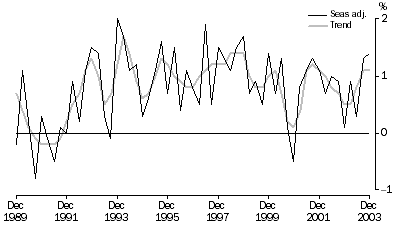
Growth (in seasonally adjusted chain volume terms) over the past 4 quarters has been driven by a continued pattern of strong household final consumption expenditure (up 5.5%), private business investment (up 10.0%) and dwelling investment (up 6.4%). Offsetting these strong contributions were imports of goods and services (up 10.2%) and exports of goods and services (down 0.5%). On the industry side, the strongest contributors over the past 4 quarters were agriculture, forestry, fishing and hunting (up 28.5%), wholesale trade (up 7.3%), construction (up 6.1%), finance and insurance (up 4.6%) and ownership of dwellings (up 3.7%).
IMPACT OF 2003-04 FARM SEASON ON AUSTRALIAN PRODUCTION
Australia experienced a severe drought in 2002-03 that had a significant impact on the growth of the Australian economy. Revisions have been made to the 2002-03 estimates of farm production due to the incorporation of preliminary results from the 2002-03 Agriculture Survey, released by the ABS on 28 January 2004 and updated data from the Australian Bureau of Agriculture and Resource Economics (ABARE). The direct impact of the 2002-03 drought is now estimated to be a negative contribution of 0.9 percentage points on the volume growth of GDP between 2001-02 and 2002-03.
More favourable weather conditions in recent months indicate improved prospects for the agriculture industry in 2003-04. The ABS has calculated estimates of the likely impact of the recovery on the agricultural production based on forecasts from ABARE. The most recent forecasts were published on 17 February 2004.
The following table shows, in seasonally adjusted chain volume terms, quarterly data from September quarter 2002 to December quarter 2003 and forecasts for March and June quarter 2004. The table shows a much more marked increase in agricultural outputs than in agricultural inputs. The difference between the outputs and inputs is gross agricultural product at market prices. The expected rise in the estimates of gross agricultural product at market prices between 2002-03 and 2003-04 represents the direct impact on GDP of the recovery following the 2002-03 drought. Gross agricultural product at market prices is expected to increase in chain volume terms from $19,558 million in 2002-03 to $23,739 million in 2003-04, a rise of $4,181 million or 21.4%. If this eventuates it will make a positive contribution of 0.6 percentage points to the growth in the volume of GDP between 2002-03 and 2003-04.
AGRICULTURAL PRODUCTION, Chain volume measures(a): Seasonally adjusted |
|  |
 | 2002-03
| 2003-04
|  |
 | Sep | Dec | Mar | Jun | Sep | Dec | Mar(b) | Jun(b) |  |
 | $m | $m | $m | $m | $m | $m | $m | $m |  |
|  |
| Outputs | 9,668 | 8,300 | 8,203 | 8,410 | 9,249 | 10,354 | 10,294 | 10,339 |  |
| less inputs | 4,008 | 3,677 | 3,646 | 3,692 | 3,873 | 4,265 | 4,185 | 4,174 |  |
| Gross agricultural product at market prices | 5,660 | 4,623 | 4,557 | 4,718 | 5,376 | 6,089 | 6,109 | 6,165 |  |
| Gross domestic product | 182,704 | 182,920 | 184,519 | 185,164 | 187,663 | 190,200 | na | na |  |
|  |
| na not available |
 |  |  |  |  |  |  |  |  |  |
| (a) Reference year for chain volume measures is 2001-02. |
 |  |  |  |  |  |  |  |  |  |
| (b) Projections based on ABARE forecasts. |
 |  |  |  |  |  |  |  |  |  |
The graph below, in seasonally adjusted chain volume terms, shows the projected outputs for five major categories of agricultural output. Most of these data are based on ABARE forecasts. The improved performance of the farm sector is expected to be driven by cropping industries, with the rise in the output of cereals forecast to more than double in 2003-04. Caution should be exercised in interpreting the quarterly seasonally adjusted forecasts as revisions to the seasonally adjusted estimates may be expected as additional information becomes available.
Farm output(a), Chain volume measures(b)—Seasonally adjusted
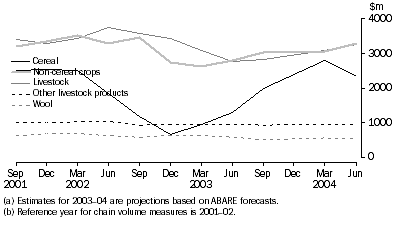
For a complete picture of the impact of the improved farm production on GDP, both the direct and indirect effects of the sector must be considered. Indirect effects can be put into two categories. The first category is the effect on downstream industries, principally transport, wholesale trade and the manufacturing of products from agricultural outputs. The second category comprises the multiplier effects arising from the increased value of production by the agriculture industry and its downstream industries. This has two elements. One arises from any increase in the inputs of these industries which leads to an increase in the production of other Australian industries. The other arises from any increase in factor income of the agriculture and downstream industries that leads to a rise in final expenditures by farmers and others who draw an income from these industries. These indirect effects are described in more detail in a feature article published in the September quarter 2002 issue of this publication.
2003 Rugby World Cup
The 2003 Rugby World Cup (RWC) was a major international sporting event, held over 44 days in October and November 2003. A total of 48 games were played across Australia in all states and territories except the Northern Territory. Significant economic activity and revenue was generated from the event, which has been reflected in the December quarter 2003 national accounts aggregates. ln general, the treatment of the RWC was similar to that for the Sydney Olympics, although the scale of the event was smaller. A feature article explaining the treatment, titled 'Statistical Treatment of the 2003 Rugby World Cup', was published in the June quarter 2003 issue of this publication.
The expenditures of non-resident visitors (both participants and spectators) were recorded as exports of goods and services. The expenditures of Australians were recorded in the relevant components of household final consumption expenditure. Components that were affected included:
- Recreation and culture- including ticket sales, recorded at the time the RWC takes place, and not when payments are actually made
- Transport services- reflecting services provided to move persons between and around the various states and capital cities
- Hotels, cafes and restaurants- reflecting the food, accommodation and other associated services provided to Australian resident RWC participants and spectators.
Corresponding effects, attributable to both resident and non-resident activity, were reflected in the gross value added estimates for the relevant industries.
Data provided to the ABS by the Australian Rugby Union (on a confidential basis) were used to supplement existing data sources used to compile the national accounts. In most cases, the existing data sources included activity associated with the RWC. However, generally it is not possible to separately identify this activity from other similar activity that is not specifically related to the RWC.
Further information may be obtained from Michelle Williams on (02) 6252 5845, or by email at michelle.williams@abs.gov.au.
Real gross domestic income
A measure of the real purchasing power of income generated by domestic production is the chain volume measure of GDP adjusted for the terms of trade effect, which is referred to as real gross domestic income (see glossary for definition). The graph below provides a comparison of quarterly movements in trend GDP (chain volume measure) and real gross domestic income. During the December quarter, trend real gross domestic income increased by 1.5%, compared to the increase in the trend chain volume measure of GDP of 1.1%, reflecting an improvement in the terms of trade. Trend and seasonally adjusted estimates of real gross domestic income are shown in tables 1 and 2.
PERCENTAGE CHANGES, Trend

The graph below shows the trend terms of trade over the past fourteen years.
Trend, (2001–02 = 100)

Real net national disposable income
A broader measure of changes in national economic well-being is real net national disposable income. This measure adjusts the chain volume measure of GDP for the terms of trade effect, real net incomes from overseas and consumption of fixed capital (see glossary for definition). The graph below provides a comparison of quarterly movements in trend GDP (chain volume measure) and real net national disposable income. During the December quarter, trend real net national disposable income increased by 1.6%, while the increase in the trend chain volume measure of GDP was 1.1%.
Percentage Changes, Trend

Household saving ratio
In both trend and seasonally adjusted terms the household saving ratio (see glossary for definition) was negative in the December quarter 2003 implying that household consumption was greater than household disposable income. In trend terms the ratio was -2.4% in the December quarter and in seasonally adjusted terms it was -2.7%. The following graph presents the household saving ratio derived from trend and seasonally adjusted data.
Household saving ratio, Current prices
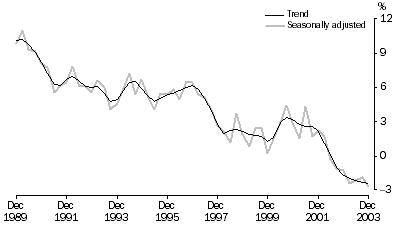
The deterioration in the saving ratio in recent quarters has been driven by both a slow down in the rate of growth of disposable income and the continued strength of household consumption expenditure. Although seasonally adjusted household saving has been negative in the past seven quarters, net national saving has been positive over the same period. The net national saving ratio in the December quarter was 4.2% in seasonally adjusted terms.
Caution should be exercised in interpreting the household saving ratio in recent years, because major components of household income and expenditure may still be subject to significant revisions. The impact of these revisions on the saving ratio can cause changes in the apparent direction of the trend.
Compensation of employees
In the December quarter 2003, seasonally adjusted compensation of employees grew by 1.2%, while the seasonally adjusted number of employees recorded in the Labour Force survey grew by 0.3%. Thus, average compensation per employee increased by 0.9%. This follows growth of 0.6% and 1.7% in the previous two quarters. The growth rate over the 12 months to December quarter 2003 was 3.4% (in seasonally adjusted terms) compared to 3.7% growth in the Wage Cost Index (cat. no. 6345.0) over the same period. (It should be noted that the conceptual bases for the two wage measures are different.)
It is noted that following the introduction of the new method for calculating compensation of employees in March quarter 2002 the estimation of average earnings is not as direct as under the previous approach and hence the decomposition of national accounts estimates of compensation of employees into an employment component and an average earnings component may be of lower quality.
Private non-farm inventories to total sales ratio
In trend current price terms, the book value of private non-farm inventories increased by $121 million (0.1%) in the December quarter 2003, while total sales rose by $1228 million (1.0%). Consequently, the inventories to total sales ratio (see glossary for definition) fell from 0.776 in the September quarter 2003 to 0.769 in the December quarter 2003. The following graph presents the ratio of private non-farm inventories to total sales over the last fourteen years.
Trend, Current Prices
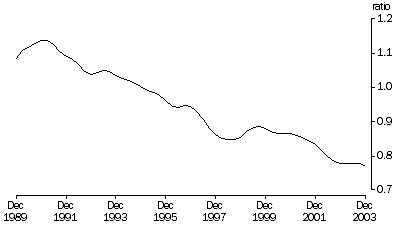
Imports to domestic sales
The imports to domestic sales ratio (see glossary for definition), trended and at current prices, fell from 0.343 in the September quarter 2003 to 0.330 in the December quarter 2003. This reflects a fall of 1.8% in imports of goods accompanied by a 2.2% rise in domestic sales. The following graph presents the ratio of imports to domestic sales over the last fourteen years.
Trend, Current Prices
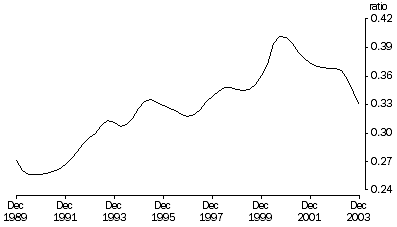
Reliability of contemporary trend estimates
Trend estimates are used throughout this publication as an alternative approach to the analysis of movements in time series data. Further details regarding the procedures used to estimate the trend series are described in the Explanatory notes (paragraphs 13-17) and in the ABS Information Paper: A Guide to Interpreting Time Series-Monitoring Trends, 2003 (cat. no. 1349.0) released in August 2003.
Potential revisions to trend estimates can be indicated by showing the effects of particular changes in seasonally adjusted estimates that might occur in the next quarter. The table below shows the trend estimates for the last ten quarters and the values to which they would be revised if the given movements in seasonally adjusted GDP actually occurred in March quarter 2004. Seasonally adjusted growth of 0.7% is required in March quarter 2004 to maintain, in March quarter 2004, the trend growth of 1.1% currently estimated for December quarter 2003.
Percentage change in GDP-Chain volume measure |
|  |
 |  |  |  | Trend estimate if seasonally adjusted GDP changes by the following amounts in Mar qtr 2004
|  |
 |  | Seasonally adjusted GDP as published in Table 1 | Trend GDP as published in Table 1 | Grows by 1.0% | No change | Falls by 1.0% |  |
|  |
| 2001 |  |  |  |  |  |  |
 | September | 1.3 | 1.2 | 1.2 | 1.2 | 1.2 |  |
 | December | 1.1 | 1.1 | 1.1 | 1.1 | 1.1 |  |
| 2002 |  |  |  |  |  |  |
 | March | 0.7 | 1.0 | 1.0 | 1.0 | 1.0 |  |
 | June | 1.0 | 0.8 | 0.8 | 0.8 | 0.8 |  |
 | September | 0.9 | 0.7 | 0.7 | 0.7 | 0.7 |  |
 | December | 0.1 | 0.5 | 0.5 | 0.5 | 0.5 |  |
| 2003 |  |  |  |  |  |  |
 | March | 0.9 | 0.5 | 0.5 | 0.5 | 0.5 |  |
 | June | 0.3 | 0.8 | 0.8 | 0.8 | 0.9 |  |
 | September | 1.3 | 1.1 | 1.1 | 1.0 | 1.0 |  |
 | December | 1.4 | 1.1 | 1.2 | 0.9 | 0.7 |  |
|  |
Revisions since the September quarter 2003 release
In the compilation of the December quarter accounts, more up-to-date source data has been included that has revised estimates, particularly for the previous five quarters. In addition, a number of series have been seasonally reanalysed. The main revisions are as follows.
On the income side of GDP the gross operating surplus of private non-financial corporations was revised to reflect corrected interest flow data and the gross mixed income of unincorporated enterprises was revised due to the incorporation of preliminary results from the 2002-03 Agriculture Survey.
On the production side of GDP revisions were made to agriculture due to the incorporation of preliminary results from the 2002-03 Agriculture Survey. Updated source data also led to the revision of construction industry gross value added.
On the expenditure side of GDP, new machinery and equipment, non-dwelling construction and dwellings were all revised due to both updated source data and a seasonal reanalysis. General government state and local gross fixed capital formation was revised due to a seasonal reanalysis.
 Print Page
Print Page
 Print All
Print All